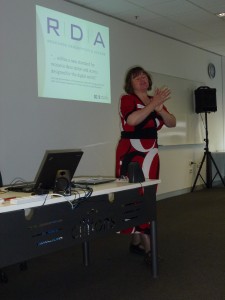This SCIS Asks 2013 presentation by Alan Manifold, Digital and Library Applications Manager at the State Library of Victoria sets the future of library discovery architecture in the context of the evolution of library systems and search. Alan outlined the purpose of metadata as being to:

SCIS, CC-by-nc
- Authorize
- Limit
- Evaluate
- Categorize
- Link
He postulated that the format of the item no longer matters, it is about providing connections between resource and curriculum and resources inside and outside the library. The catalogue which was once designed for inventory control has morphed into a search engine.
Alan posed questions about the evolution in libraries and catalogues in the age of electronic resources, searchable full text and mega-aggregate sites. He touched upon discovery products such as EBSCO, WorldCat Local and the State Library of Victoria’s Primo Central. A useful observation was that while school students need authoritative information as soon as possible, they tend not to require a specific title or edition of a work.
His advice was that SCIS needs to provide connections between resources and curriculum and external indexes and search platforms. He recommends SCIS
- continue to provide quality metadata
- increase the connecting of resources with curriculum
- work on linking controlled vocabularies
- highlight diversity of resources and formats and
- explore ways to rate materials
Education Services records its thanks to Alan for his clear thinking and recommendations.


